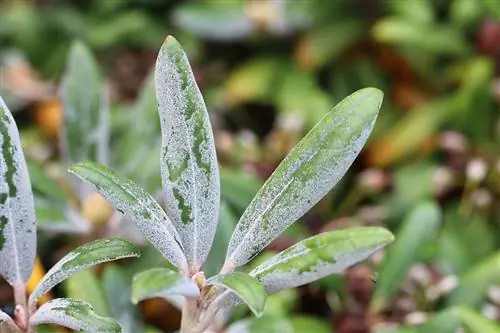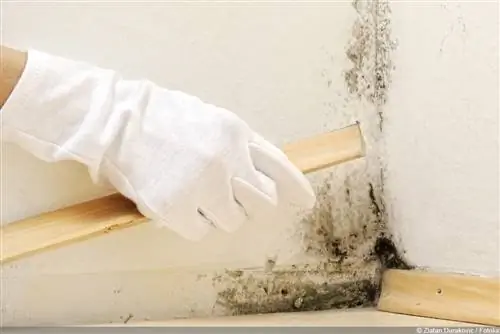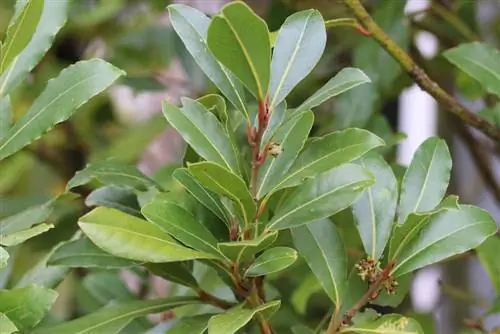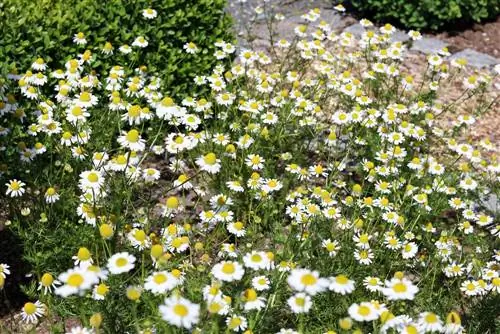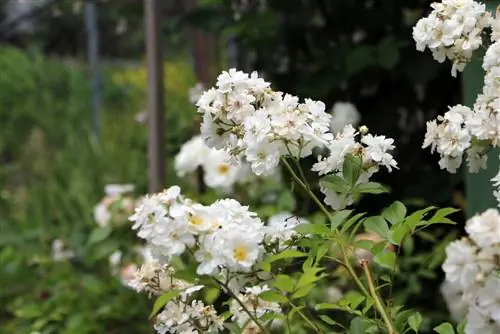- Author admin [email protected].
- Public 2023-12-17 03:39.
- Last modified 2025-01-24 12:45.
Both powdery mildew and downy mildew are fungal diseases that, under optimal conditions, spread rapidly throughout the entire garden and can affect almost all useful and ornamental plants. Since the causative fungal spores are extremely robust and fungal infestation is difficult to combat, as many preventative measures as possible should be taken to prevent an outbreak of mildew in the garden.
The distinguishing features of mildew
Powdery mildew (Erysiphaceae) is a plant disease that is caused by ascomycota fungi (Ascomycota) and primarily affects plant leaves, for example by the fungal spores being carried by the wind and deposited on the plants and sticking there. The spores then germinate, causing the leaves to initially be covered by a floury white coating. As the disease progresses, the leaves under the fungal network increasingly turn brownish before drying out completely. Roses and fruit trees are considered particularly threatened, although powdery mildew, which thrives particularly well in sunlight, can also affect other plant species.
Downy mildew (Peronosporaceae) is caused by so-called egg fungi (Oomycota). In contrast to the ascomycete spores, the spores of the egg fungi in question penetrate significantly deeper into the interior of the plants. In addition, the coating that gives it its name, which is also mealy white, appears primarily on the underside of the leaves in downy mildew. Another distinguishing criterion is that downy mildew only thrives when there is sufficient moisture, especially since the fungal spores only reach any stomata on wet leaves via a kind of water film, through which they can then penetrate into the interior of the plant. Although this type of mildew can also affect various plant species, radish and cabbage plants are particularly threatened.
When it comes to mildew, it's better to be safe than sorry
Since both powdery mildew and downy mildew are highly contagious, you should take precautionary measures from the outset to prevent a fungal infection from occurring in the first place. First of all, this means that you only grow, sow or plant plants that are as resistant as possible. In addition, you should choose the location carefully. With regard to plants that are particularly susceptible to powdery mildew, this means that you should avoid locations that are too sunny. In relation to downy mildew, it means that the location must not be waterlogged and that, ideally, it is protected from rain as much as possible.
Anyone who wets their garden should, especially with regard to downy mildew, ensure that at least susceptible plants are always watered in soil moisture so that the plants themselves do not become unnecessarily wet. In this context, the maxim also applies that sometimes less is more. This means that you should not overdo it when watering, as soil that is too wet can promote the development of downy mildew, not least due to the evaporating liquid. In addition, if possible, watering should only be done in the late morning and/or early afternoon, especially since a high level of moisture combined with the coolness of the evening or night would unnecessarily promote the development of mildew.
It is also important to avoid monocultures, as they are already very susceptible to disease. In addition, mildew finds the optimal conditions to thrive in monocultures, which could lead to increased spore formation and thus a larger accumulation of spores, which in turn would pose a greatly increased risk to the rest of the garden. When it comes to mixed crops, however, care must be taken to ensure that they are not composed of plant species that are all susceptible to a particular type of mildew.
In addition, you can try to make your plants more resilient with the help of certain tonics that you either prepare yourself from what your own garden has to offer or that you buy ready-made from specialist retailers. There is also the option of treating potentially endangered plants with purchased or home-made repellents.
Fighting mildew
If, despite all caution, a plant is affected by downy or powdery mildew, the affected leaves should first be removed. As a precaution, it is advisable to remove even the adjacent leaves that do not yet show any symptoms of disease. Depending on the extent of the mildew infestation and the type of plant affected, you should even consider removing the entire plant if in doubt.
Before touching other parts of plants or plants in general, it is essential to thoroughly clean your hands or the tools used to remove the leaves or plants. In addition, the removed leaves or plants should be burned, buried deep away from potentially endangered plants or even disposed of with residual waste.
It is commonly said that you could just as easily throw the leaves into the compost, as mildew would only thrive on living plant material. However, this would involve taking an unnecessary risk, as the pathogenic spores could still be transmitted by the wind or insects. Regardless, there is no guarantee that the mildew pathogens will actually rot, so at least theoretically there remains a risk that you will spread the mildew in the form of compost in your garden over the course of the next gardening season. However, if you still want to compost the plant residues, you should at least cover them with a few layers of garden waste that is guaranteed to be free of mildew pathogens.
What you should know about powdery mildew in brief
Without a doubt, mildew can become a major threat to the entire garden. If you take the precautionary measures mentioned here, the risk of mildew infestation remains low. And even if there is an outbreak of mildew, there are enough home remedies that can actually help. Specialist retailers also stock highly effective fungicides. In the worst case scenario, you will have no choice but to part with plants you love. However, the chance that the rest of the garden will remain free of mildew is very high.
- The damage caused by powdery mildew is a whitish, flour-like coating on the leaves.
- This is mainly found on the top of the leaves, on the flowers, the stems and the fruits.
- The fungi are mostly found on cucumbers, apples, gooseberries, vines, roses and ornamental plants such as phlox.
Attention: Powdery mildew looks different on strawberries and grapes! The undersides of the strawberry leaves turn red. You can hardly see any white coating on the top. However, they curl the leaves upwards. That is a clear sign. It's similar with grape leaves. As the disease progresses, the grapes burst open.
Prevention
- It is advisable to choose resistant varieties when purchasing vegetable and garden plants.
- When planting, the planting distances should not be too close in order to reduce the risk of infection.
- It also helps the plants if they find space in open and sunny locations
- Powdery mildew overwinters on the shed leaves and next year's buds. That's why the leaves have to be picked up in autumn.
- The usual winter pruning is also important to prevent powdery mildew.
Combat
- If it is too late and individual shoots are already infected, they should be cut out thoroughly.
- Sulfur-containing preparations are primarily used to combat this, e.g. B. Baymat or Saprol. These are available in garden centers.
- Suitable home remedies are whey and milk, diluted with water. (Milk 1:9 water and whey 1:30 water). Spray this mixture over the affected plants, ideally two to three times a week.
- The natural enemies of powdery mildew include ladybirds and other small creatures.
What you should know about downy mildew in brief
The downy mildew fungi primarily attack wine, spinach, lettuce, strawberries and many other plants. They occur more frequently in humid weather or in humid climates in greenhouses. You can recognize them by the fact that light spots appear on the top of the leaves. A grayish coating forms on the underside of the leaf.
Prevention
- The first priority is to choose a resistant variety.
- A generous planting distance should also be taken into account.
- When watering and watering, make sure that the water does not run over the leaves and settle there.
- The breeding ground for fungi could develop well here. Over-fertilization also has a beneficial effect on the infestation.
Combat
- Copper preparations are used in chemical control. Fungisan, Compo Ortiva and other fungicides against downy mildew are also available in stores.
- It is best to treat the plants with plant strengthening agents as a preventive measure and at the first signs of infestation.
- It is important to cut out and destroy all parts of the plant that are being attacked at the first sign! They don't belong in the compost!
- Leaf-strengthening broths and other plant strengthening agents that are injected are ideal. You can make it yourself (nettle broth) or buy e.g. horsetail extract from Deudorff.
- Effective chemical agents are rose fungus-free Saprol (Celaflor) and Fungisan rose-fungus-free (Neudorff).
- Organic spray from Schacht, a natural plant strengthener, is recommended as a biological spray.
Editor’s TIP
Fungal spores also survive on garden tools, wooden posts, perennial supports, rose arches, privacy fences, trellises and the like, all made of organic material. Everything that has come into contact with diseased plants or parts of plants must be cleaned! An antiseptic or alcohol is ideal for cleaning. This is also recommended for the hands.


